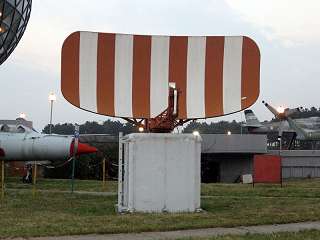Cossor CR 21
Description of the radar set, tactical-technical characteristics

Figure 1: Cossor CR 787 radar, formerly used on the top of the tower of the Airport “Beograd”
(© Aeronautical Museum-Belgrad)

Figure 1: Cossor CR 787 radar, formerly used on the top of the tower of the Airport “Beograd”
(© Aeronautical Museum-Belgrad)
| Specifications | ||
|---|---|---|
| SR 21 | SR 787 | |
| frequency: | 2 940 … 2 980 MHz (S-Band) | |
| pulse repetition time (PRT): | ||
| pulse repetition frequency (PRF): | 770 Hz | |
| pulsewidth (τ): | 1 µs | |
| receive time: | ||
| dead time: | ||
| peak power: | 500 kW | |
| average power: | 385 W | |
| instrumented range: | 70 NM (≙ 130 km) |
100 NM (≙ 185 km) |
| range resolution: | ||
| accuracy: | ||
| beamwidth: | 1.4° | |
| hits per scan: | ||
| antenna rotation: | 12 or 20 min-1 | 12 min-1 |
| MTBCF: | ||
| MTTR: | ||
Cossor CR 21
The Cossor CR 21 was an operating in S-Band standard ATC primary surveillance radar manufactured by Cossor Radar and Electronics Ltd. It could be used in a mobile or static role. Vertical coverage extends from 0-45 deg without tilting or switching off the beam. A 15 m² target is seen at a range of at least 70 NM at over 40,000 ft and larger aircraft at up to 100 NM. It used a fixed frequency magnetron. Features included moving target indication, for cancellation of permanent echoes and circular polarization by means of a quarterwave plate to detect an aircraft target in rain clutter of about 20 dB.
The CR 21 was the direct successor to the ACR 6 and used a number of electronic assemblies from this predecessor. In the Royal Air Force the mobile version of the CR 21 was also known as the ACR 7C.
Cossor CR 787
Type CR 787 is similar but incorporates a microwave low-noise pre-amplifier for 25 per cent greater range and reduced receiver noise. Its accuracy was sufficient for talking down even small jet aircraft. Both radars were in service in Australia, New Zealand, Africa and Europe between 1957 and the late 80s.
Sources:
- Manufacturers Leaflet
- Aeronautical Museum-Belgrad
- News and information website Flight Global, Archive page 12. July 1957
